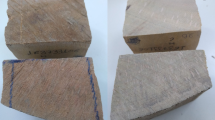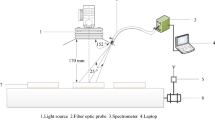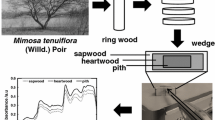Abstract
The potential of visible and near infrared (Vis-NIR) spectroscopy to distinguish wet-pockets from normal subalpine fir (Abies lasiocarpa Hook) wood was evaluated. Two specimen classes were used, namely, wood with more than half of the surfaces covered by wet-pockets (WW), and wood completely free of wet-pockets (NW). A partial least square (PLS) regression model was derived and calibrated to predict moisture content ranging from 0 to 210%, and its usefulness for moisture-based sorting of green lumber was assessed. Samples were sorted into the two classes after Vis-NIR scanning via two models: (1) soft independent modeling of class analogy (SIMCA) and (2) PLS discriminant analysis. The SIMCA model using second derivatives and wavelengths spanning 650 to 1150 nm successfully classified 98% of WW and NW in the green state, while it resulted in misclassification of 96% of the specimens after air-drying. The discriminant PLS model using wavelengths spanning 650–1150 nm, correctly classified WW and NW 96% in the green state and 100% after air-drying, respectively. These results clearly demonstrate the applicability of Vis-NIR spectroscopy to discriminate wet-pockets from normal wood.
Zusammenfassung
Untersucht wurde die Möglichkeit, Nasskern von Tannenholz (Abies lasiocarpa Hook) von normalem Holz mittels Spektroskopie im sichtbaren und im Nahinfrarotbereich (Vis-NIR) zu unterscheiden. Zwei Gruppen von Prüfkörpern wurden untersucht: Holz mit über 50 % Nasskern an der Oberfläche (WW) und Holz ohne Nasskern (NW). Zur Bestimmung des Feuchtegehaltes im Bereich 0 bis 210 % wurde ein partielles Regressionsmodell (PLS) hergeleitet und kalibriert sowie dessen Anwendbarkeit zur Sortierung von frischem Schnittholz nach der Holzfeuchte beurteilt. Nach der Vis-NIR-Prüfung wurden die Proben mittels zweier verschiedener Diskriminanzanalysen (SIMCA, PLS) in die zwei Gruppen eingeteilt. Mit dem SIMCA-Modell, das zwei Ableitungen und Wellenlängen im Bereich von 650 bis 1150 nm verwendet, konnten 98 % WW und NW im frischem Zustand richtig zugeordnet werden, wohingegen nach der Lufttrocknung 96 % falsch klassifiziert wurden. Das PLS-Modell mit Wellenlängen im Bereich 650 bis 1150 nm klassifizierte im frischen Zustand 96 % WW und NW richtig und nach Lufttrocknung 100 % richtig. Diese Ergebnisse belegen deutlich die Anwendbarkeit der Vis-NIR-Spektroskopie zur Unterscheidung zwischen Nasskern und normalem Holz.






Similar content being viewed by others
References
Adedipe EO, Dawson-Andoh B (2008) Predicting moisture content of yellow-poplar (Liriodendron tulipifera L.) veneer using near infrared spectroscopy. For Prod J 56(4):28–33
Barker N, Rayens W (2003) Partial least squares for discrimination. J Chemom 17:166–173
Bauch J, Höll J, Endeward R (1975) Some aspects of wetwood formation in fir. Holzforschung 29:198–205
Cai L (2005) Determination of diffusion coefficients for sub-alpine fir. Wood Sci Technol 39:153–162
Flaete PO, Haartveit EY (2004) Non-destructive prediction of decay resistance of Pinus sylvestris heartwood by near infrared spectroscopy. Scand J For Res 19(Suppl 5):55–63
Geladi P (1988) Notes on the history and nature of partial least squares (PLS) modeling. J Chemom 2:231–246
Gierlinger N, Schwanniger M, Hinterstoisser B, Wimmer R (2002) Rapid determination of heartwood extractives in Larix sp. by means of Fourier transform near infrared spectroscopy. J Near Infrared Spectrosc 10:203–214
Gierlinger N, Jacques D, Schwanninger M, Wimmer R, Hinterstoisser B, Pâques LE (2003) Rapid prediction of natural durability of larch heartwood using Fourier transform near-infrared spectroscopy. Can J For Res 33(9):1727–1736
Heraud P, Bayden RW, Beardall J, McNaughton D (2006) Effects of pre-processing of Raman spectra on in vivo classification of nutrient status of microalgal cells. J Chemom 20:193–197
Hoffmeyer P, Pedersen JG (1995) Evaluation of density and strength of Norway spruce wood by near infrared reflectance spectroscopy. Holz Roh- Werkst 53:165–170
Karttunen K, Leinonen A, Sarén M-P (2008) A survey of moisture distribution in two sets of Scots pine logs by NIR-spectroscopy. Holzforschung 62:435–440
Kelley SS, Rials TG, Groom LR, So C-L (2004) Use of near infrared spectroscopy to predict the mechanical properties of six softwoods. Holzforschung 58:252–260
Kozlik CJ, Ward JC (1981) Properties and kiln-drying characteristics of young-growth western hemlock dimension lumber. For Prod J 31(6):45–53
Mackay JFK (1975) Properties of northern aspen discolored wood related to drying problems. Wood Fiber 6(4):319–326
Poke FS, Raymond CA (2006) Predicting extractives, lignin, and cellulose contents using near infrared spectroscopy on solid wood in Eucalyptus globules using near infrared reflectance analysis. J Wood Chem Technol 26:187–199
Poke FS, Wright JK, Raymond CA (2004) Predicting extractives and lignin contents in Eucalyptus globules using near infrared reflectance analysis. J Wood Chem Technol 24:55–67
Ross RJ, Ward JC, TenWolde A (1994) Stress wave nondestructive evaluation of wetwood. For Prod J 44(7/8):79–83
Savitzky A, Golay MJE (1964) Smoothing and differentiation of data by simplified least square procedures. Anal Chem 36(8):1627–1639
Schink B, Ward JC (1984) Microaerobic and anaerobic bacterial activities involved in formation of wetwood and discoloured wood. IAWA Bull New Ser 5(2):105–109
Schneider MH, Zhou L (1989) Characterization of wet-wood from four balsam fir trees. Wood Fiber Sci 21:1–16
Schroeder HA, Kozlik CJ (1972) The characterization of wetwood in western hemlock (Tsuga heterophylla). Wood Sci Technol 6(2):85–94
Simpson W (1991) Dry kiln operator’s manual, forest products laboratory. Madison, Wisconsin, pp 274
Taylor AM, Freitag C, Cadot E, Morrell JJ (2008) Potential of near infrared spectroscopy to assess hot-water-soluble extractive content and decay resistance of a tropical hardwood. Holz Roh- Werkst 66:107–111
Thygesen LG, Lundqvist SO (2000a) NIR measurement of moisture content in wood under unstable temperature conditions. Part 1. Thermal effects in near infrared spectra of wood. J Near Infrared Spectrosc 8:183–189
Thygesen LG, Lundqvist SO (2000b) NIR measurement of moisture content in wood under unstable temperature conditions. Part 2. Handling temperature fluctuations. J Near Infrared Spectrosc 8:191–199
Tsuchikawa S, Yamato K, Inoue K (2003) Discriminant analysis of wood-based materials using near-infrared spectroscopy. J Wood Sci 49:275–280
Ward JC (1986) The effect of wetwood on lumber drying times and rates: an exploratory evaluation with longitudinal gas permeability. Wood Fibre Sci 18(2):288–307
Ward JC, Groom D (1983) Bacterial oak: drying problems. For Prod J 33(10):57–65
Ward JC, Zeikus JG (1980) Bacteriological, chemical and physical properties of wetwood in living trees. In: Bauch J (ed) Natural variations of wetwood in living properties. Mitt. Bundesforschungsanst, vol 131. Forest Holzwirtsch, Hamburg, pp 133–165
Watanabe K, Hart F, Mansfield SD, Avramidis S (2010) Detection of wet-pockets on the surface of Tsuga heterophylla (Raf) Sarg by near infrared (NIR) spectroscopy. Holzforschung 64:55–60
Williams PC, Sobering DC (1993) Comparison of commercial near infrared transmittance and reflectance instruments for analysis of whole grains and seeds. J Near Infrared Spectrosc 1:25–32
Wold S (1976) Pattern recognition by means of disjoint principal components models. Pattern Recognit 8:127–139
Author information
Authors and Affiliations
Corresponding author
Rights and permissions
About this article
Cite this article
Watanabe, K., Mansfield, S.D. & Avramidis, S. Wet-pocket classification in Abies lasiocarpa using spectroscopy in the visible and near infrared range. Eur. J. Wood Prod. 70, 61–67 (2012). https://doi.org/10.1007/s00107-010-0490-2
Received:
Published:
Issue Date:
DOI: https://doi.org/10.1007/s00107-010-0490-2




